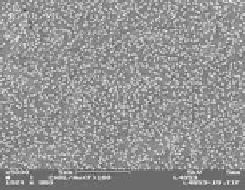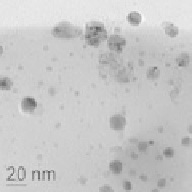Biomedical Engineering Reference
In-Depth Information
(a)
(b)
(c)
(d)
(e)
(f)
Figure12.9
Microscopicimagesofmetal/CNXLcompositesafterthermaltreatmentat200
◦
C
for 2h; FESEMimages of Ag(a) andAu(b) onCNXL, andTEMimages of Ag(c), Au(d), Pt(e),
andPd(f)onCNXL.Aninset in(d)denotesselectedareaelectrondiffractions(SAED).
loading (10.7 wt% (Figure 12.9a)), which shows a broad size distribution of close packed
silver nanoparticles with trace amount of tree-shaped crystalline silvers (tens of micron
sizes). The size and distribution of silver nanoparticles will directly influence the per-
formance of composites. Controlling the size and distribution of the silver nanoparticles
is related to the temperature and time of the thermal treatment and the loading of silver.
Au nanoparticles were relatively easy to control in size and distribution under the
thermal treatment. Figure 12.9b and d show FESEM and high-resolution TEM images
of well-distributed and homogeneous Au nanoparticles (10-15 nm), which are highly
crystalline (inset: SAED). Figure 12.9e and f show high-resolution TEM images of Pt
and Pd nanoparticles. These elemental metal nanoparticles are also easy to control in size:
Pt (3-4 nm) and Pd (10-15 nm). Such highly ordered supported metals can be utilized
as catalysts in the areas of direct methanol fuel cell (51) and organic synthesis (52).
12.4.3
Nanocrystalline Se
Elemental selenium is an indirect bandgap semiconductor with good photoelectrical and
semiconducting properties (53, 54). Selenium also has a high reactivity towards many
different metal ions to form other 1D functional materials such as CdSe, ZnSe, Ag
2
Se etc (55). In addition, selenium is one of the essential trace elements for human
health because it exerts anti-oxidative (56) and pro-oxidative effects (57). Selenium
nanoparticles have recently been developed for applications in medical diagnostics (58).






Search WWH ::

Custom Search